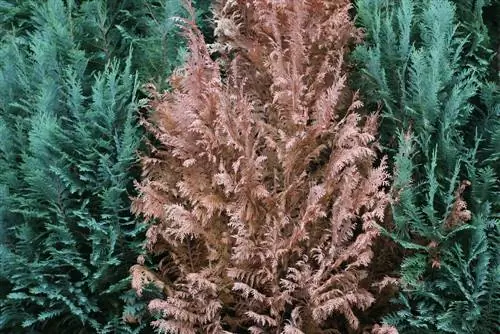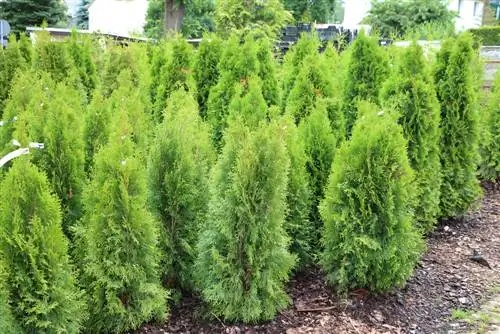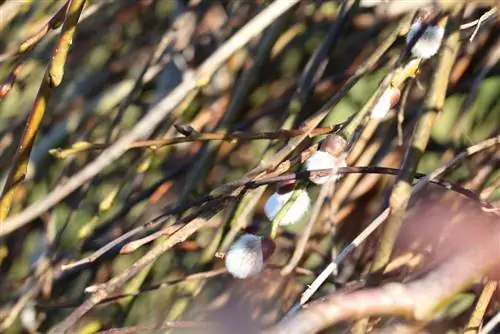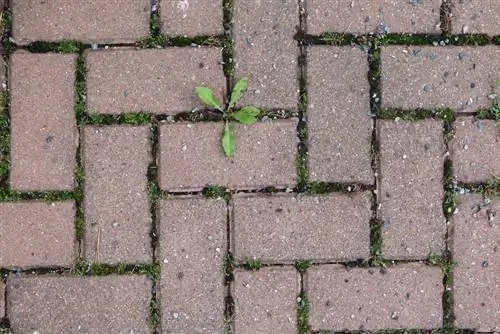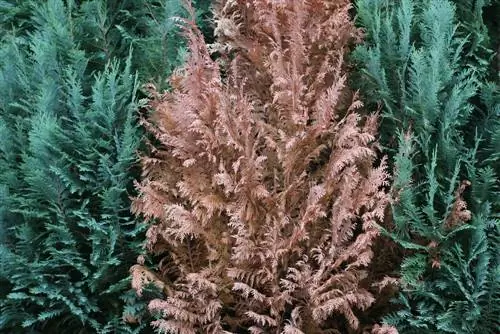- Author admin [email protected].
- Public 2023-12-17 03:39.
- Last modified 2025-06-01 06:48.
The thuja hedge only grows into an impressive, dense green wall if it is pruned regularly. Since this is never forbidden unless you cut through a bird's nest, there are few excuses; postponing the cut is better this way, because Thuja hedges are easy to cut; at least as long as this happens consistently.
This is how cutting the Thuja hedge begins
The Thuja hedge is one of the classic hedges that is often used as a property border. The reason for this is that the trees, known in German as the tree of life, are evergreen, offer a dense green appearance, grow very slowly, can get very old and can still be grown into representative “green walls” with very little care.
In just a few years you can grow a hedge that surrounds the property, looks very solid and yet contains nothing other than “green”. However, the prerequisite is that you trim the hedge correctly and regularly during these years. This is how the Thuja hedge becomes an impressive green property border:
- In the first year after the usual planting in spring, the young hedge plants are allowed to grow in peace without pruning
- If they were planted in autumn, the young plants do not necessarily need a cut next spring
- Root formation is very slow over the winter, the thujas still need this first warm season to take root
- That's why they don't grow at full strength in the upper area
- A little shaping is possible in the first year: Individual branches that grow strongly are carefully trimmed with secateurs
- This is possible at any time (more on this below) and is necessary because these cross runners influence the growth of the rest of the tree if they become too strong
- When the young plants are well rooted, pruning can begin
- Then definitely if you want it to be a nice, dense hedge
- The thuja hedge gets its main cut in spring
- The sometimes advocated June/July cut shortly before the second growth phase is not recommended despite good wound healing
- Because at this time the border to the old wood is difficult to see, cuts that are too deep happen quickly
- Since the arborvitae in the green area tolerate pruning very well, the hedge can be cut shortly before it sprouts
- This encourages the hedge plants to branch out further when the spring shoots begin immediately afterwards
- The new shoots also ensure that the hedge only looks “like it’s fresh from the hairdresser” for just a few days
- If it is to be a hedge made up of Thuja hedge cones standing side by side, the individual plants are first pruned individually
- Because such cones only look good if they have approximately the same strength
- We need to work towards this, one plant needs to be slowed down more, the next one needs to be encouraged more
- At the end of the cut, the contours of the hedge created from the individual plants are corrected
- If you want a continuous green rectangular hedge, cut from the start with the entire hedge in mind
- A good aid is a height-adjustable tension cord on two earth pillars
- If you cut along this line, you can work very precisely without much effort
- In the first few years, the basic rectangular shape of the thuja hedge is created
- It should always be slightly conical (tapering slightly towards the top, why will be explained later)
- The conclusion is a straight horizontal line at the top of the hedge (the great moment of the tension cord)
- During the season, all individual branches that grow out should be removed in these formative years
- The more careful you are now, the more even the thuja hedge will be
- Because there is no need for later correction, the branch that has once grown crooked remains crooked, even if it gets older and thicker
Tip:
The classic “tree of life” hedge is almost irreplaceable in places that always have to look representative, because few other hedge plants are so easy to keep in order. However, it is not a hedge that helps the wild animals in the area with their lives: The most common Thuja species sold as a hedge plant (Thuja 'Smaragd', Thuja 'Brabant') is the western arborvitae Thuja occidentalis, native to northeastern Canada and the USA, The other Thuja species we offer come from North America or Eastern Asia. These aliens are largely biologically dead, they do not feed our birds or our insects, and the (smelly) Thuja hedges are not particularly popular as a nesting place. If it has to be Thuja, then it is best not alone; With just a few native bird protection trees such as barberry and elderberry, dog roses, sloes or rowanberries (which do not need to be cut, at most they need to be shaped a little in autumn) you can help keep our wildlife alive.
Ongoing pruning care - a fight against baldness
As soon as the thuja hedge has grown into a beautiful, green, solid rectangle, the gardener has to “cut back” that this rectangle loses its greenery. Because there is a reason why it was recommended above not to let the side walls of the Thuja hedge run vertically upwards:
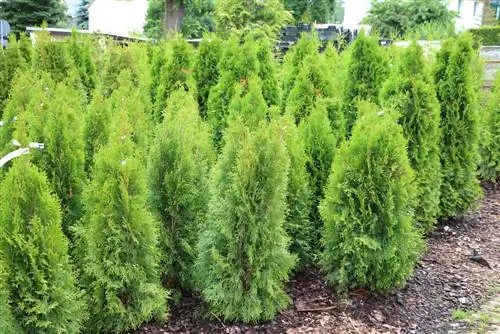
Trees of life are cypress plants that develop increasingly thick branches under the densely set, scale-shaped leaves. The thick trunk wood of the North American species used in forestry, which grows in individual positions, is known as “Red Cedar” (red-brown, Thuja plicata) and “White Cedar” (light, Thuja occidentalis) and has been used since the post-war period, for example. B. as a wooden shingle v. a. imported to Germany from Canada. Where the Thuja hedge grows thick wood or where the branches of the Thuja are completely woody, fresh shoots with green leaves no longer sprout, this is what is meant by baldness.
In order to prevent this baldness from the inside out, you must cut as close as possible to the branch mass that is currently becoming woody. Since the lower branches are more woody than the upper ones, the logic results in the conical structure of the hedge, which should remain green from bottom to top for as long as possible. If the thuja hedge was allowed to grow as it wanted, soon all that would be visible below would be bare branches, which would make the lower area of the hedge “transparent” and not really nice to look at.
Therefore, you should keep an eye on the growth rate in the first year in which the Thuja hedge “grows vigorously” after it has taken root. If the thuja grows very quickly, it will become woody very quickly, and you should pick up the hedge trimmer again at the end of September. Whether this is so, you see; Whether it is likely depends on the cultivar and the given location. The original common arborvitae (the “ancestor” of all Thuja occidentalis, in which the green scale leaves turn significantly brown in winter) and the cultivar T. occidentalis 'Brabant' (which also has deep green leaves in winter) grow particularly quickly.
Tip:
If you are dealing with a “thuja hedge that has grown away”, e.g. For example, if you have taken over a hedge that is fully grown at the top and bare at the bottom, advice on regular trimming will be of very little use to you. Unfortunately, decisive and deep pruning of an old thuja hedge does not provide the quick solution that is desired in this situation. You can cut thuja into old wood, and conifers also create so-called “sleeping eyes” that are activated when cutting measures/loss of wood threaten the existence of the tree. But these sleeping eyes are called that because they have to be activated first; and they are only formed from trees in sufficient numbers that have never suffered from shortage. Therefore: Drastic cutting back into the old wood is basically possible, but it is a risky matter that does not immediately lead to the beautiful green hedge again. You can find more about radical pruning and a step-by-step plan for saving an old Thuja hedge in the article “Cutting Thuja hedges - normal and radical pruning explained”. Incidentally, “growing away” can start unexpectedly: the cultivar T. occidentalis ‘Sunkist’ grows narrow and slowly when young, but increases significantly in speed and width as it ages.
When hedge trimming is prohibited
Since 2010, Section 39 Para.5 No. 2 Federal Nature Conservation Act (BNatSchG) stipulates nationwide that hedges may not be cut off or put on the stick (radical cut except for short stubs) from March 1st to September 30th. The reason is to protect wild birds, because birds build nests in hedges and trees between March and September and hatch their young there. If you really wanted to get rid of an entire hedge between March and September (containing bird nests that you then cut out from under the birds), you would be in trouble with nature conservation regulations.

Since the regular trimming of a Thuja hedge is scheduled shortly before the start of the breeding season and the possible second trimming shortly after the end of the breeding season, you will normally hardly come into conflict with the nature conservation law when trimming the Thuja hedge. If you have missed the permitted trimming time, the following applies:
- According to Section 39 Paragraph 5 No. 2 last half sentence BNatSchG, gentle shaping and care cuts to eliminate the growth are permitted
- So actually exactly the ongoing care cuts that you want to do right now
- It sounds as if Section 39 Para. 5 BNatSchG with regard to hedges would only be relevant for “putting it on the stick”
- But it's not quite like that:
- You may only complete the annual main cut during the breeding season if two requirements are met
- First, the hedge must be thoroughly searched for bird nests
- If any were found, the hedge should not be cut until the young birds have fled
- With Thuja, however, you hardly run any risk in this regard
- Because if there is only a little “usable nature” nearby, the thuja hedge remains “biologically dead”
- However, some local birds these days are in real distress to find nesting sites and are grasping at any straw
- There have been several reports online about blackbirds nesting in thuja as a matter of course
- The second requirement is that no more should be cut off than the growth added last year
- No problem with hedge trimming, as a rule a little less than the annual growth is cut away
- Also permitted in the breeding season are individual cuts of diseased, broken, diseased branches
If you are planning larger pruning measures during the breeding season, it is best to contact the local environmental office (after unsuccessfully searching for a bird's nest, of course). No obligation, but tactically very clever, because you take the wind out of the sails of every conceivable objection from conservationists or neighbors right from the start. This can usually be done simply over the phone, with a short description of the project (I have to cut my hedge now because) and the assurance that there are no bird nests in the hedge, and you note the name of the employee in the office so that you can refer to him in case of doubt (this was discussed with Mr.

